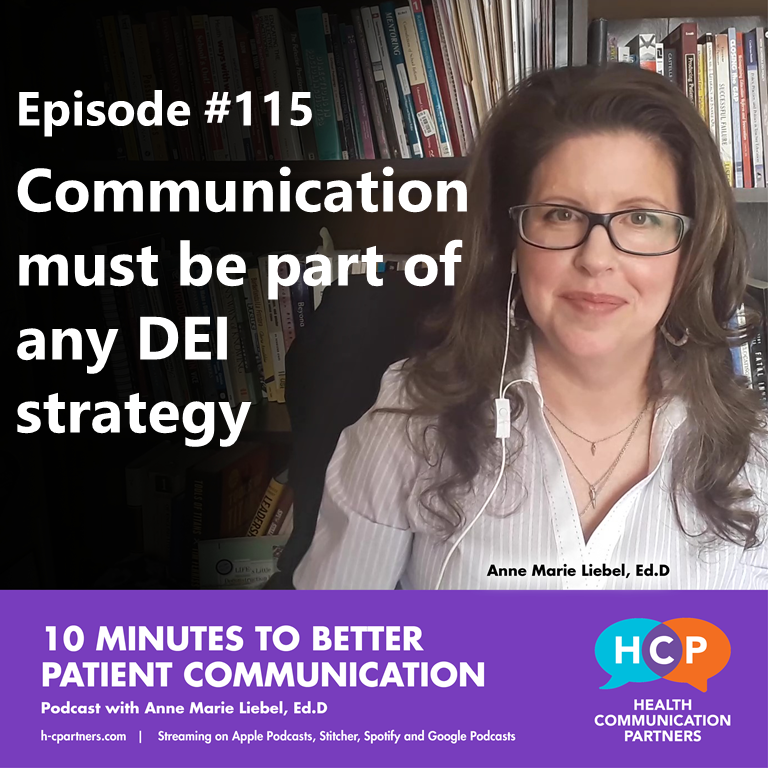In and beyond healthcare, American workers are quitting their jobs in record numbers–and this trend shows little signs of slowing. Employers who want to attract and retain talent are talking up their DEI strategy in order to be competitive. Here’s why communication must be part of any successful DEI strategy, and how you can get started.

Many organizations have recently made a public commitment to diversity, equity, and inclusion. But communication is often-overlooked in DEI strategy. No matter where your organization is in its DEI efforts, focusing on strong foundations – like intentional communication – is a crucial investment. So I’ll suggest some small actions that can go a long way toward your organization’s DEI goals. Hi everybody. I’m Dr. Anne Marie Liebel. This is 10 Minutes to Better Patient Communication from Health Communication Partners, an independent health-equity focused education and communication consultancy. If your organization needs expert help with any topic in this series, visit healthcommunicationpartners.com.
Today’s episode sponsored by Maven Roth Group. Maven Roth is a progressively strong, women-owned creative agency. From designing images, reports, logos, templates, and social graphics for your organization, to spreading the word thru digital, print, billboards, radio and television, Maven Roth has you covered, all the way to media buying and management. Visit mavenroth.com today.
Now it makes sense that organizations want to be able to enjoy the many benefits of DEI efforts. Some are looking for ways to start or initial steps to take. Then there are others who have a track record of pursuing DEI values. They are more concerned with how to measure impact, how to choose appropriate targets and plan how to reach them, in ways that contribute to business growth. For both of these scenarios, a focus on communication is key.
Whether your organization is bringing diverse people together to innovate, improve the bottom line, create a safe work environment, strengthen the organizational brand, or increase market share, communication is integral. Taking a holistic view of DEI, as I help my clients do at Health Communication Partners, means making sure communication is part of DEI strategy and action. Intentional communication is a crucial aspect of any DEI strategy.
But communication is often-overlooked. This is a mistake you don’t want to make, because communication is a large component of everyday business operations. Paying attention to communication is powerful because communication has both personal and organizational traits, which will not be a surpise to you if you’ve listened to this show before. We each participate in communication as individuals. And communication is a key part of an organization’s culture. Communication has significant impact on people’s professional growth, participation, advancement, and relationships.
I have helped organizations of all sizes with communication as part of their DEI strategy and I’ll share with you some of what I’ve helped them do. So think about some of the internal communication going on in your organization. And I’ll suggest some relatively small actions that can go a long way toward using communication as a lever for DEI strategy and action.
 Interpersonal communication
Interpersonal communication
Successful DEI efforts can mean that professionals who have not traditionally worked together are finding themselves around the same table. Sometimes a virtual table, right? Sometimes a metaphoric table, sometimes a literal table. Organizations whose workforce has not historically been diverse might face some communication challenges as they diversify. One of them is that employees may have gotten used to communicating with people who are like them. Talking with people who are like us is part of what we all do on a regular basis. Again you know this if you’ve listened to this show before. It’s not problematic in itself. But our taken-for-granted ways of communicating can lead to some awkwardness, if not outright difficulties, when someone from a different social background enters the conversation.
Why? Dr. Katherine Phillips at Columbia Business School, explains: “Members of a homogeneous group rest somewhat assured that they will agree with one another; that they will understand one another’s perspectives and beliefs; that they will be able to easily come to a consensus.” Again there’s nothing wrong with this, it’s part of how language works in social groups.
But Professor Phillips reminds us that “the leadership ranks of the business world remain predominantly white and male.” So people from different social groups, with different perpsectives, beliefs, and assumptions will likely change the communication landscape of an organization. As your organization becomes more diverse, you’ll talk with, work alongside, and otherwise interact with people who have different communities, commitments, and backgrounds than you have. People on your team may be coming from different places, or standing in different spaces–economically, politically, or culturally–than others on the team.
Your organization will want to keep their eye on this, because talking to people from other social, cultural, even professional backgrounds is not necessarily intuitive. And the force of “the way we’ve always communicated around here” is powerful. Here’s something you can do right now.
Consider: How would you describe your organization’s current style of or approach to internal communication? What’s often taken for granted? What are the hidden rules? How might this style of communicating dissuade people with diverse perspectives from participating?
Meetings
From years as a consultant and an employee, I have learned that talk at meetings is a powerful element of corporate culture. Meetings are potent organizational and social events. In meetings, people can use talk to make many things happen, or at least attempt to. They can define problems in a particular way, argue for their perspectives and priorities, enact roles, and prioritize or sideline specific ideas or people. Even the language of a meeting agenda communicates what is appropriate to talk about, how it should preferably be talked about, and usually, who gets to do the talking.
But if left unexamined, the communication habits around your organization’s meetings may unintentionally make it easier for some people to participate than others. This threatens one of the deep benefits to having a diverse workforce: employees being able to leverage their different perspectives, experiences, and knowledge bases. As University of Michigan Professor Scott Page points out, “If you don’t bring a lot of diverse lenses to bear, you’re likely to have blind spots and make mistakes.” Hiring employees with diverse backgrounds is an essential step, but representation is not enough. People need to participate, and much participation is done through communication.
You’ve heard me say before: Different people are more comfortable speaking in some places, or to some people, than others. We also can feel more or less confident in our knowledge, depending on where we are, and who is listening. It is possible for the way that communication is handled in and around meetings to make space for diverse voices. Here’s how you can start:
how does the talk during meetings at your organization favor certain ways of communicating over others? Another way to ask this is: What type of communication goes furthest in your organization’s meetings? Even a small shift in the communication habits around your organization’s meetings can invite more inclusive participation.
Clarify terms
Lastly I want to talk about terminology. Not a surprise, right? The term DEI itself can present communication problems. DEI is now a part of the national conversation which is great news (and way overdue!). When we’re all using a term, like DEI, it can be easy to assume we all know what it means. But that’s not necessarily the case. A 2017 study of global executives by Russell Reynolds Associates found that only 24 percent of respondents “are aware of a definition of inclusion” and only 47 percent believed that their companies have a “clear, holistic understanding of diversity.” Last year at HCP we released a podcast episode on why it is important to be clear-headed about how the use of the term “health equity.” So how your organization defines diversity, equity and inclusion makes a difference. It makes a difference for demonstrating progress and evaluating impact. When so many of us use the same term, it’s easy to assume we mean the same thing by it. But the popularity of a term can make it difficult for us to notice when there are real and substantial differences in our understandings, our goals, our approaches. Speaking as a researcher, I’ll remind you that differences in meaning–or fuzziness about definition of a term–also will have an impact when it comes to measurement. Here’s what you can do.
Find out what your organization means by diversity, inclusion, and equity. This doesn’t have to be a one and done. These definitions can (and probably should) evolve. If you’re not sure where to begin, it can be as easy as starting with an online search for “diversity meaning.” Also, you might check out how your competitors are defining these terms. Over time, you might also consider what “diversity,” “equity” and “inclusion” have to do with each other. And be sure employees are involved at every step.
I have helped organizations of all sizes strategize and act on these issues. If your organization needs support with more equitable communication, contact me on twitter, Linked. Or visit HealthCommunicationPartners.com and click on contact.
